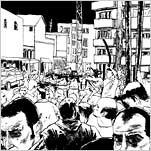TONY BRANCATELLI, A CLEVELAND CITY COUNCILMAN, yearns for signs that something like normal life still exists in his ward. Early one morning last fall, he called me from his cellphone. He sounded unusually excited. He had just visited two forlorn-looking vacant houses that had been foreclosed more than a year ago. They sat on the same lot, one in front of the other. Both had been frequented by squatters, and Brancatelli had passed by to see if they had been finally boarded up. They hadn’t. But while there he noticed with alarm what looked like a prone body in the yard next door. As he moved closer, he realized he was looking at an elderly woman who had just one leg, lying on the ground. She was leaning on one arm and, with the other, was whacking at weeds with a hatchet and stuffing the clippings into a cardboard box for garbage pickup. “Talk about fortitude,” he told me. In a place like Cleveland, hope comes in small morsels.

City Councilman Tony Brancatelli and other officials in Cleveland are grappling with at least 10,000 abandoned homes, many owned by lenders or speculators who trade them like baseball cards. More Photos »
Multimedia
The next day, I went with Brancatelli to visit Ada Flores, the woman who was whacking at the weeds. She is 81, and mostly gets around in a wheelchair. Flores is a native Spanish speaker, and her English was difficult to understand, especially above the incessant barking of her caged dog, Tuffy. But the story she told Brancatelli was familiar to him. Teenagers had been in and out of the two vacant houses next door, she said, and her son, who visits her regularly, at one point boarded up the windows himself. “Are they going to tear them down?” she asked. Brancatelli crossed himself. “I hope so,” he mumbled.
Prayer and sheer persistence are pretty much all Brancatelli has to go on these days. Cleveland is reeling from the foreclosure crisis. There have been roughly 10,000 foreclosures in two years. For all of 2007, before it was overtaken by sky-high foreclosure rates in parts of California, Nevada and Florida, Cleveland’s rate was among the highest in the country. (It’s now 24th among metropolitan areas.) Vacant houses are not a new phenomenon to the city. Ravaged by the closing of American steel mills, Cleveland has long been in decline. With fewer manufacturing jobs to attract workers, it has lost half its population since 1960. Its poverty rate is one of the highest in the nation. But in all those years, nothing has approached the current scale of ruin.
And in December, just when local officials thought things couldn’t get worse, Cuyahoga County, which includes Cleveland, posted a record number of foreclosure filings. The number of empty houses is so staggeringly high that no one has an accurate count. The city estimates that 10,000 houses, or 1 in 13, are vacant. The county treasurer says it’s more likely 15,000. Most of the vacant houses are owned by lenders who foreclosed on the properties and by the wholesalers who are now sweeping in to pick up houses in bulk, as if they were trading in baseball cards.
Brancatelli and others — judges, the police, city officials, residents — are grappling with the wreckage left behind, although to call this the aftermath would be premature. Even with President Barack Obama’s plan to help prevent foreclosures, the city is bracing for more, especially as more people lose their jobs. The city’s unemployment rate is now 8.8 percent. Moreover, on some streets so many houses are already vacant that those residents left behind are not necessarily inclined to stay. “It just happens so fast, the sad part is you really have little control,” Brancatelli told me. “It snowballs on the street, and you try to prevent that avalanche.” Walking away from a house even makes a kind of economic sense when the mortgage far exceeds the home’s value; Obama’s foreclosure-prevention plan does little to address that situation. Now outside investors have descended on Cleveland; they pick up properties for the price of a large flat-screen TV and then try to sell them for a profit.
So much here defies reasonableness. It’s what Brancatelli keeps telling me. A few months ago, he met with Luis Jimenez, a train conductor from Long Beach, Calif. Jimenez had purchased a house in Brancatelli’s ward on eBay and had come to Cleveland to resolve some issues with the property. The two-story house has a long rap sheet of bad deals. Since 2001, it has been foreclosed twice and sold four times, for prices ranging from $87,000 to $1,500. Jimenez bought it for $4,000. When Jimenez arrived in Cleveland, he learned that the house had been vacant for two years; scavengers had torn apart the walls to get the copper piping, ripped the sinks from the walls and removed the boiler from the basement. He also learned that the city had condemned the house and would now charge him to demolish it. Brancatelli asked Jimenez, What were you thinking, buying a house unseen, from 2,000 miles away? “It was cheap,” Jimenez shrugged. He didn’t want to walk away from the house, but he didn’t have the money to renovate. The property remains an eyesore. “Generally, I’m an optimist, but none of this makes sense,” Brancatelli told me. “Trying to give order to all this chaos is the big challenge.”
This article has been revised to reflect the following correction:
Correction: March 8, 2009
The cover article on Page 28 this weekend about efforts by













